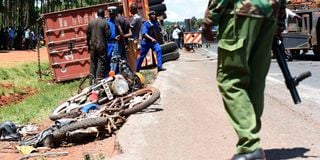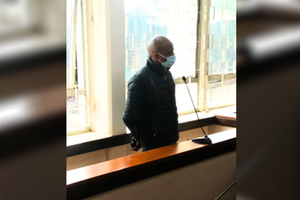Establish trauma hospitals along highways to reduce road accident fatalities

Police officers and members of the public at the scene of a road crash involving a transit goods truck and two motorcycles along the Eldoret-Webuye highway in Turbo Township.
What you need to know:
- Although global south countries like Kenya have fewer cars compared to their global north counterparts, it is sad that we have more road accidents than them.
- Scholars have found this to be linked to poor transport infrastructure, weak or non-existent transport laws and poor law enforcement (few enforcement officers, corruption, among others).
Recently, the country has been inundated with news of road accidents from all corners of the republic. While most Kenyans have in turn trained their guns on Transport Cabinet Secretary Kipchumba Murkomen to contain the menace, there are multiple other stakeholders that need to play their roles to reduce the rising tide and the attendant lives lost. A starting point would be to look at all the contributors to the accidents while also looking at a wide net of preventive measures.
Although global south countries like Kenya have fewer cars compared to their global north counterparts, it is sad that we have more road accidents than them. Scholars have found this to be linked to poor transport infrastructure, weak or non-existent transport laws and poor law enforcement (few enforcement officers, corruption, among others).
The CS has in the past promised a raft of measures to reduce road carnage. Unfortunately, the pronouncements and directives, though welcome, are yet to bear fruit.
The other issue is that the National Transport and Safety Authority (NTSA) death statistics that we keep receiving are often crash site figures. There are victims who die in hospitals and are often missed in the NTSA data. With this in mind, though prevention is better than cure, in instances where accidents have already happened, it is important to understand how deaths are distributed and how to best reduce such deaths.
Deaths from accidents occur along a temporal spread divided into three peaks (trimodal distribution of trauma mortality). The first peak occurs within minutes and is due to unsurvivable injuries like brainstem injury, heart rupture, among others. Nearly half of deaths occur in this phase. The next peak occurs within one to three hours and constitutes up to three of every 10 trauma deaths, while the final peak is observed days to weeks later, arising from complications of the injuries, (or intervention) leading to organ failure.
It is at the second peak where significant health intervention is needed to reduce the death rate. This is made possible by availability of surgeons, imaging, blood transfusion and operating theatre services. To succeed in saving lives at this phase, we talk of the 'golden hour', where the patient should be attended to within an hour of the accident. To achieve the golden hour target, well stocked hospitals with imaging (X-ray, ultrasound and CT scans), theatre and blood transfusion services must be set up at identified accident black spots. They should then be staffed with surgeons and other healthcare workers.
A while back when a driver of a trailer lost control and rammed into a litany of traders along the Nakuru-Kericho highway, the nearby Londiani Sub-county Hospital did not have capacity to perform major trauma surgeries. The facility has no resident surgeon. At the county referral hospital, the emergency and imaging departments as well as the operating theatre are not located in an optimal single section of the facility. Such hampers optimal surgical intervention within the golden hour.
Prior research has demonstrated that public hospitals along major highways handle a lot of accidents. This information should guide policy on infrastructure and staffing.
In a recent conversation with a former Ministry of Health insider, I was impressed by the existence of a masterplan drafted during the reign of Prof Anyang’ Nyong'o — 2008 to 2013 — that sought to establish regional centres of excellence. This was to consider disease burden and facility capabilities as well as capture both public, faith-based and private facilities — think of a public cancer centre, a private paediatrics centre, a faith-based cardiac centre to name a few.
It is time to revisit such policies and implement them. Specifically, the national and county governments need to establish trauma centres along accident hotspots across the country. The 2022 Kenya Demographic and Health Survey has enough details on where to start such an intervention. Of course without staffing, these facilities can only remain as structures with no impact.
Dr Aruyaru is a consultant general surgeon and chief medical officer at PCEA Kikuyu Hospital




